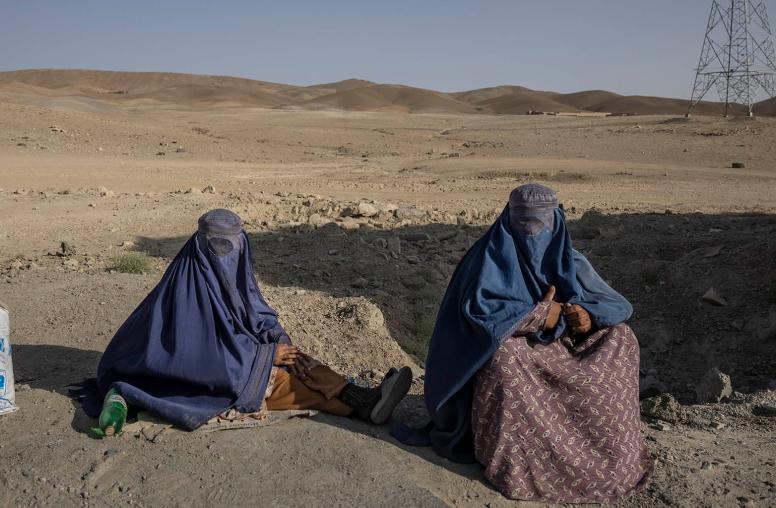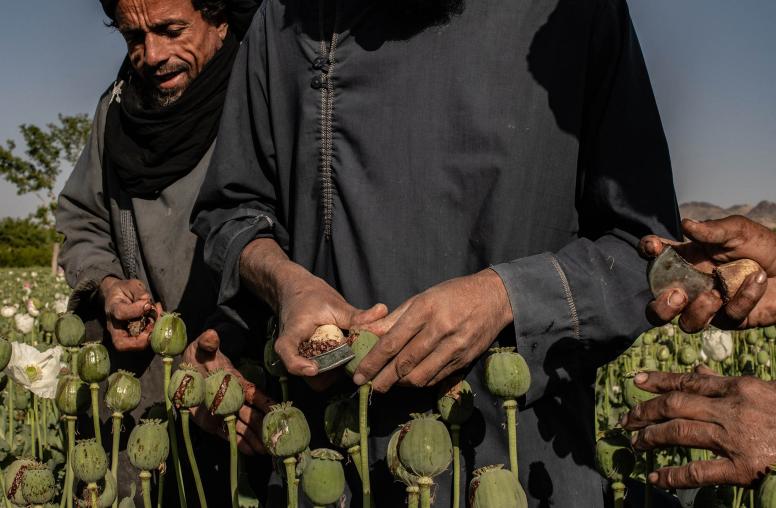Laura Bush Urges Sustained Support for Afghan Women
Former First Lady Spotlights Women’s Progress, New Book at USIP Forum
Former first lady Laura Bush said the international community must continue to support the reconstruction of Afghanistan and progress for the country’s women through aid, investment and an ongoing presence of American troops. Speaking at the U.S. Institute of Peace on March 15, Bush said she remains hopeful for the country’s future, in part because of the spirit of Afghan women and the strides they have made in education, business and government.

“We need to help them build an economy so people can have jobs, so people can make money, so people can become independent,” said Bush, who traveled to Afghanistan three times as first lady. “But obviously the most important thing is security.”
Bush appeared at USIP to discuss a book produced by the George W. Bush Institute and released last week, “We Are Afghan Women: Voices of Hope.” The volume, with an introduction by the former first lady, features 28 Afghan women telling in their own words how they overcame challenges including repression, abuse, exile and war to change their lives and Afghan society.
The book is part of a broader effort by current and former officials and other advocates to keep a focus on Afghanistan as the international presence there wanes and violence resurges amid new Taliban gains on the battlefield. Periodic talk of negotiations with the Taliban to end the fighting also has raised alarms that women’s advances would be bargained away as part of a deal.
Bush said she was “heartened” by President Barack Obama’s decision to reverse a plan for complete withdrawal of American forces this year and instead to keep U.S. troops in the country through 2016 and beyond. The U.S. and the international community should help Afghans establish the security necessary to continue rebuilding the nation, she said. And to develop the economy, she said, “we ought to figure out how to get some for-profits in there” to join the non-profits that are working on development projects in the country.
Advocating for Education, Women
Bush has been a public supporter of advancing opportunity for Afghan women since she delivered the Nov. 17, 2001, weekly presidential radio address on the subject as first lady. It was the first time a first lady had taken the president’s place for the weekly broadcast.
She helped launch the American University of Afghanistan, which opened in 2006, and is an honorary co-chair of the U.S.-Afghan Women’s Council with fellow former first lady Hillary Clinton and Rula Ghani, wife of Afghan President Ashraf Ghani. The council was established within the U.S. State Department by President George W. Bush and Hamid Karzai, then-president of Afghanistan and moved to Georgetown University in 2008. The council’s goal is to “improve the education, health, economic and leadership status of Afghan women and children.”
Bush spoke at USIP alongside Mina Sherzoy, who also is a member of the U.S.-Afghan Women’s Council and the founder of an NGO in Afghanistan that teaches women entrepreneurship and business skills. Her story of flight and return to Afghanistan is told in the book. The Bush Institute is the public policy arm of the 43rd president’s library and museum complex in Dallas, and Bush serves as the chair of its Women’s Initiative, guiding programs to advance economic opportunity, good health and human freedom for women and girls.
USIP’s board chairman, Stephen Hadley, who moderated the discussion with Bush and Sherzoy, asked the former first lady what motivated her to take on Afghan women as a cause—and to stay with it for so many years after leaving the White House.
“Right after September 11th, when the spotlight turned on Afghanistan, American women, including myself, saw women who were marginalized, who were left out,” she said. “The very idea of a government that would forbid half of its population from being educated was shocking to Americans.”
Among the people who called her wanting to take action was one of her best friends from Houston. “She said ‘I used to be so glad I wasn’t in your shoes, but now I wish I were. I’m jealous. Because you can do something and I can’t.’’ The formation of the U.S.-Afghan Women’s Council followed, along with many other projects to support “our Afghan sisters,” Bush said.
'Heartbroken'
In her introduction to the book, Bush says that as she learned more about Afghanistan, what she discovered left her “heartbroken.”
After 22 years of warfare—first an insurgency against the Soviet Union after its 1979 invasion, then factional anarchy among the victorious mujahedeen—70 percent of Afghans were malnourished and one in four children died by the age of 5. More than 6 million people had fled the country and as many as 2 million were displaced within Afghanistan. About 10 percent of the population had died as a result of the fighting.
The repression of women initiated by the mujahedeen, meanwhile, had become an even more severe policy under the Taliban. It was, wrote Bush, “a form of gender apartheid never before seen in the modern world.”
“Women were shut up in their homes. Women were forbidden from attending school, forbidden from working,” she wrote. They were barred from showing their faces in public and beaten by the religious police for leaving home without a male guardian.
Today, girls’ access to education is one of the most significant achievements of the past decade in Afghanistan, Bush wrote. Fifteen years ago, fewer than 5,000 girls were enrolled in primary school. That number soon will exceed 3 million, more than 40 percent of total enrolled students. Secondary schools have graduated 120,000 girls, and 15,000 have completed college.
In other milestones, 36 percent of teachers are women. In government, women hold 69 of 249 seats in parliament. Of 25 government ministers, four are female, and there are two female provincial governors. About 3,000 businesses in the country are owned and operated by female entrepreneurs. Afghanistan’s first lady, Rula Ghani, has launched a project to establish a female-only university, run by women, which Bush said deserved international support to provide an option for women from more conservative families.
“Afghan women are not the same as 14 years ago,” said Sherzoy. “They have learned their rights and they are still learning. They have learned how to advocate.”
For all the gains, the erosion of security poses a rising threat after $1 trillion of U.S. spending on the Afghan conflict. Fighting between the Taliban and government forces has escalated, with civilians increasingly snared in suicide bombings, improvised explosive devices and targeted attacks by the militants.
“Businesses are closing, there are a lot of unemployed,” said Sherzoy. “It adds to the instability.”
In her closing remarks, Bush reiterated the need for the U.S. to remain engaged in supporting Afghanistan and in particular for U.S. troops to remain to help promote stability.
If the U.S. and its international allies pull out of Afghanistan too quickly, the situation would very likely return to the anarchy that prevailed in the 1990s, according to Andrew Wilder, the vice president of Asia programs at USIP. The country would once again become a haven for transnational terrorist groups—the reason the U.S. toppled the Taliban in 2001—and the tremendous gains made by the Afghan people, especially women and girls, would be lost.



